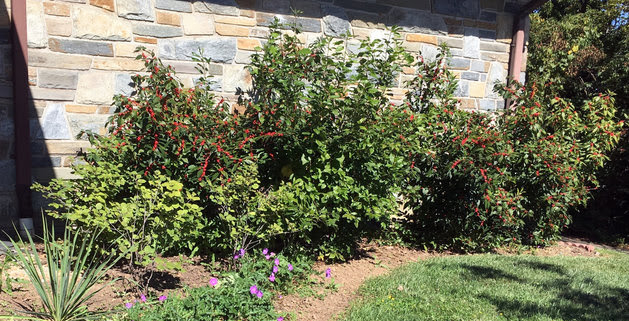Spruce Up your Foundation Plantings
Photo and article by Plant NOVA Natives
When developers build a neighborhood, they almost always add some shrubs against the foundations of the houses to soften the lines of the buildings. Just as they paint all the interior walls white, they use just a few conventional plant species for a uniform look until all the houses are sold. The new owners get used to the look and never bother to change it. But the foundation planting area offers a big opportunity to beautify the landscaping, eliminate the need for pruning and help support our local birds and butterflies at the same time.
Native shrubs constitute an essential middle layer of the ecosystem, providing food and shelter for songbirds. Providing this layer in our yards is even more important in areas where the deer have eradicated native shrubs in the woods. Unfortunately, at the time when most of our houses were built, the importance of using native plants was not known to the builders, and so most of the commonly used plants are species that were introduced from other continents. Not only do they not provide food for wildlife, many of them have escaped into nearby natural areas, where they proceed to destroy the ecosystem there. Examples of that include Nandina (also problematic because its red berries are poisonous to Cedar Waxwings), Japanese Barberry (also problematic because it harbors ticks), Privet, Burning Bush, Leatherleaf Mahonia, Double-file and Linden Viburnum, and several species of Bush Honeysuckle.
Luckily, there are many non-invasive alternatives. Best of all, many of these are native plants and therefore support the birds and butterflies with which they evolved. These plants have become increasingly available at our local garden centers. For the area under a window, it makes sense to choose one whose ultimate height when full grown will not block the view, thus making pruning unnecessary and allowing the plant to assume its own graceful shape. Many have beautiful spring flowers; others have striking red berries that provide interest well into winter.
Of course, most people don’t know the names of the shrubs in their yards. This can be figured out by using a plant ID app such as Seek or iNaturalist. Residents can also get a free visit from an Audubon-at-Home volunteer to help identify invasive plants and strategize about alternatives.
Shrubs are not the only plants that are suitable for foundations. Small trees where there is room, native ornamental grasses in the sun and native ferns in the shade are all natural choices. For those who like the conventional look that came with the house, there are plenty of native shrubs that can achieve the same aesthetic. Other people might want to add character to their yard by choosing something a little different. And rather than planting annuals every spring, why not plant a few native perennials just once to get that pop of color year after year? For more details, see the shrubs page and the foundation planting page on the Plant NOVA Natives website.




